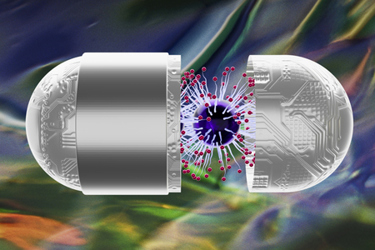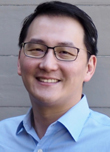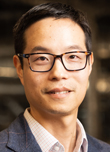Gene Circuits And Biofabs: Building The Evolution

By Louis Garguilo, Chief Editor, Outsourced Pharma

Can’t find a bio fabrication plant for your gene circuits? I’ve located a candidate.
These components arrive in a for-contract, state-of-the-art capability being carved out by an emerging biopharma.
Senti Bio (“Senti”; Nasdaq: SNTI) is a gene circuit developer with two programs just shy of the clinic. (More on all this below.)
The facility opening for contract business – a biofab, they call it – is in Alameda, California, and was formerly a part of Senti Bio.
It’s now a CDMO with the “D” specifically indicating “design.”

Senti cofounder Timothy Lu will remain CEO of the biotech. The other founder, Philip Lee, who had been CTO, moves to the independent service provider as its CEO.
Lee had spearheaded Senti’s process development, CMC, and manufacturing, and says Lu, “Philip built out the facility.”
GeneFab’s Alameda facility consists of 92,000 square feet – currently 42,000 commissioned to focus on clinical GMP services for advanced therapies.

The facility was spun out of Senti to a private equity firm– GeneFab’s new owner– and officially opened for business last year with its first “client.” You guessed it, Senti Bio.
The actual business deal – a rather ingenious buy-sell-collaborate model that sees little (if any) funds initially change hands – is worth getting into a bit, but we’ll leave that discussion for another time.
Applets For Therapy
First, an overview of gene circuits.
“From a biologist perspective,” says Lu, a serial entrepreneur (and until Senti’s 2016 founding, faculty member in Massachusetts Institute of Technology (MIT) departments of Biological Engineering, and Electrical Engineering and Computer Science), “we are talking about multiple genes we design for implementation into a cell to interact in clever ways, providing enhanced levels of precision targeting control of the product.”
From a more engineering perspective, Lu draws an analogy with apps on a cell phone. "We can basically create ‘app outlets,’ each with a different function," he explains.
"You might have one app to detect cancer cells, another allowing you to turn on or off the volume or strength of the product, or another to delete the product if you don't need it anymore.
“Senti has developed a lot of these ‘applets’ over the past 8 years. Now we hope to enable the rest of the world by providing access to this technology through GeneFab.”
Start Strategic
As for Lee, prior to joining Senti he worked at EMD Millipore (now MilliporeSigma (part of Merck KgaA), as Head of Cell Culture Systems Marketing, among other roles.
I ask him why, as a start-up, Senti Bio used so much (Lu interjects “most all”) of their initial investor funding to build out a development – make that “design” – and manufacturing facility in the first place … and why spin it out now.
“Senti’s NK [natural killer cell] products are complex,” replies Lee. “Unlike a single CAR, we need to pack three or four different genes into a single vector to enable the cell to perform activites in terms of functionality, precise targeting, etc.”
That, he says, renders the manufacturing process extremely difficult, requires multiple components, “and a lot of optimization.”
When Senti started out in 2016, there simply weren’t CDMOs capable of this.
“That in-house design and manufacturing capability, purpose-built to support our synthetic biology pipeline, enabled our more complex cell and gene therapies to advance,” Lee says.
The company reached a turning point of sorts in 2023. Senti’s first programs (SENTI-202 for AML, MDS and other blood cancers; (SENTI-301A for HCC and other solid tumors) are anticipated to be in the clinic in Q2 2024.
Meanwhile, other gene-therapy developers were beginning to devise increasingly complex programs, and faced a lack of service providers with capabilities or expertise to help out.
GeneFab to the rescue.
Shared Circuits
Some 50 employees from Senti Bio stayed with the facility and now work for GeneFab.
The differentiator from other CDMOs, who are in fact increasingly marketing services for complex gene-therapy products as well, brings us back to that “D” representing “design.”
The ability to outsource product design assistance, Lu and Lee feel, remains elusive, although arguably it has become the most needed component in the service-provider space today.
Process and product are “so tightly coupled that an integrated capability for doing design and manufacturing is now essential,” says Lu.
From the founding of Senti Bio, the cofounders anticipated all this.
The need for contract “gene fabs,” with a strong emphasis on design, was in fact, says Lu, “born from a vision that Phil and I had when we started the company in 2016.”
Senti Bio had always entertained thoughts of opening itself up as a service provider – and started by building capacity to serve its own programs, while the rest of the industry started catching up to more sophisticated gene-therapy approaches.
“We believed the cell and gene therapy space would advance to transform how we treat a lot of diseases. But the first-generation products are relatively simple,” says Lu. “You have a gene therapy you inject into the body. It goes everywhere, which is the challenge. A CAR T cell goes in and kills cancer cells, but it also kills a bunch of other cells.”
“Fundamentally,” Lu continues, “synthetic biology – the ability to control therapies more accurately through sophisticated genetic engineering – can overcome those issues.”
But today the anticipated bottleneck that has developed within the outsourcing model is holding back programs, and arguably the industry as a whole.
“So much time is spent designing your product in-house, but then you try to hand that off to a traditional CDMO,” says Lee. “It isn’t working. I’ve heard that from others in the space who started reaching out to us even prior to launching GeneFab.”
Notable is the flexibility shown by Senti’s initial investors in funding this evolving business strategy. That is, the creation of a generation of therapies using a proprietary “gene circuit platform” via the build out of a unique (future-forward) “biofoundry.” And only then, if the industry progresses as anticipated, open that facility to others as a contract business.
So far, the strategy has unfolded. More circuits and biofabs could be on the horizon.
